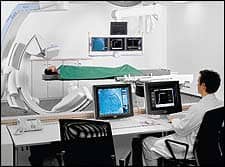
Terri Crofts
Internships are the lifeblood of the medical industry. Without opportunities for practice in the clinical setting, inexperienced physicians and nurses would dominate an industry where on-the-job training is nearly as important as classroom work. Biomedical equipment technicians and clinical engineers also serve a key function in health care delivery, and internships play a vital role in the development of new clinical/biomedical engineers and the departments that employ them.
“The clinical setting has a tradition of internships with nursing and medicine,” says Barbara Christe, MS, program director, biomedical engineering technology, associate professor, engineering technology department, Indiana University Purdue University Indianapolis. “If we didn’t offer internships to nurses and med students, we would have no future in health care.”
A Win-Win Scenario
Introducing biomedical/clinical engineering interns to a department provides several benefits. For the intern, internships provide valuable insight into the interaction between the medical and clinical engineering staffs that an educational setting, according to Christe, cannot properly convey. Internships offer opportunities to work with seasoned employees and learn new tools, as well as provide leads for jobs.

Barbara Christe
For the department, interns can assist with a stressful workload, give managers the chance to preview potential employees, and introduce new energy and ideas into a department. Whether a department utilizes interns for one or all of these benefits, the result is a net positive.
“It’s always good to have them come into the department,” says Terri Crofts, ME, director of clinical engineering at UMass Memorial Medical Center, Worcester, Mass. “They have fresh perspectives about our different methodologies and how we do things. They have an element of creativity and new ideas that they share with us. And they challenge a lot of the aspects of our program so that we continually improve things and continue to evolve to meet the demands of the environment that we’re working in. I have to believe that all of this will directly improve the care that we offer to our customers—whether it is regarding the safety of the care that they receive or the quality that they receive in the hospital environment.”
Crofts’ department has an agreement with the University of Connecticut clinical engineering master’s program to employ two clinical engineering interns at all times. Despite an initial learning curve—Crofts estimates that the interns are not truly productive members of the team for the first 6 months of their employment—her interns can perform numerous clinical engineering tasks that significantly lessen the workload for her department.

Ted Barbeau
“Our students are all doing actual clinical engineering work,” Crofts says. “We have them work on projects for equipment planning, and they also work with us on regulatory agency preparation and equipment management database work. They assist us with capital equipment replacement planning, so we have a new and refreshed list that’s updated for the administration every year. They work with us on root cause analysis, failure mode and effects analysis—which all result from incidents related to medical devices in the hospital environment—as well as on how to prevent some of the issues that are resulting from the equipment. And they help us with installation planning for all of our capital medical devices that are approved for purchase.”
Ted Barbeau, director of clinical engineering and safety officer, Saint Mary’s Health System, Waterbury, Conn, whose clinical engineering department has used interns for more than 20 years, echoes Crofts’ sentiments.
“New blood is great,” Barbeau says. “People bring in different perspectives. I’ve had interns from the community college associate program with their bachelor’s, but I’m seeing kids from Johns Hopkins University, Carnegie Mellon University, and the University of Connecticut as well. It’s wonderful to see today’s youth coming up to participate in this field. We could be struggling if we couldn’t attract talent.”
Barbeau’s interns work primarily on preventive maintenance and are used to ease his staff’s workload. “It’s never been to find prospective employees,” Barbeau says. “I use interns to lessen the workload for my staff or simply to provide an opportunity to someone that’s looking to enhance his resumé. I’ve never hired any of the interns I employed, even though I knew some of them were going to have really good careers as in-house guys or possibly department directors. Two of our interns have gone on to direct other departments. Not that I wouldn’t have, had a position been available. There’s one intern currently that I’m desperate to hire.”
Aside from the obligation her department has to the University of Connecticut program, Crofts retains interns both to reduce operating costs and to gain a perspective on potential employees.
“Through working with individuals over a couple of years, you know exactly what their work ethic is, you know if they have the appropriate work style for your organization, and if they would be a contributing member to your team,” Crofts says. “Because of our relationship with the internship program, we have hired three of the University of Connecticut students that we have used in the program.”
In addition to the benefits to the clinical/biomedical engineering departments, Christe notes comparable advantages that these internships bring to the educational setting.
“The classroom experiences are affirmed, and that’s a wonderful thing for students and for faculty,” Christe says. “It’s a set of skills that we can’t duplicate. There are a few schools that have actual patient care rooms set up for BMETs, but really the culture of the hospital is something that I can tell them about but I can’t duplicate in the classroom.”
Overcoming Resistance
Despite the benefits interns bring to clinical/biomedical engineering departments, not all departments use them. Christe believes that much of this resistance comes from the administration; primarily, a reluctance to potentially place a strain on the existing department by adding untrained personnel. “Some clinical engineering departments are overwhelmed and worried that they can’t mentor appropriately,” Christe says.
“It’s not every in-house guy that can take an intern under his wing, because they’re not all educators,” Barbeau says. “They didn’t get into this field to be educators. Some people simply work better independently than with others watching them work. That said, we all focus on customer service. To a certain extent, we all need to be able to explain what we’re doing and why we’re doing it.”
Both Barbeau and Crofts add that the financial cost of interns also causes friction.
“Given the state of the economy and continuing pressure to try to reduce our expenses and costs while improving our efficiency, there are always those pressures to try and take money out of our budgets or do things differently to improve the cost of the program,” Crofts says. “You have to be creative in your way of stating that you need additional clinical engineers, and be able to stress the components that interns contribute to cost-saving initiatives that go on in the hospital. Without the personnel to help work on various projects, I think things are even less efficient.”
“They’re free—at least in terms of a paycheck, usually—and with a focused mentoring approach you will receive a variety of services in return,” Barbeau says.
Regardless of their position in the industry—be it educator or department manager—Barbeau, Christe, and Crofts agree that utilizing interns is not only beneficial but an essential part of the biomedical/clinical engineering field. Whether a department engages interns primarily for low-cost, quality labor, as possible future employees, or as just a way to help improve the clinical engineering field, each department can benefit through their use.
And to biomedical departments that do not currently hire interns, Crofts offers a word of advice: “It’s well worth the effort to approach the administration,” she says. “The cost is minimal as it relates to the actual work that you get out of the internship program, in addition to the learning and improvement that happens in the department because of this relationship and flow of new students into the department. You can continually improve and develop your program.”
Chris Gaerig is the associate editor of 24×7. Contact him at .




